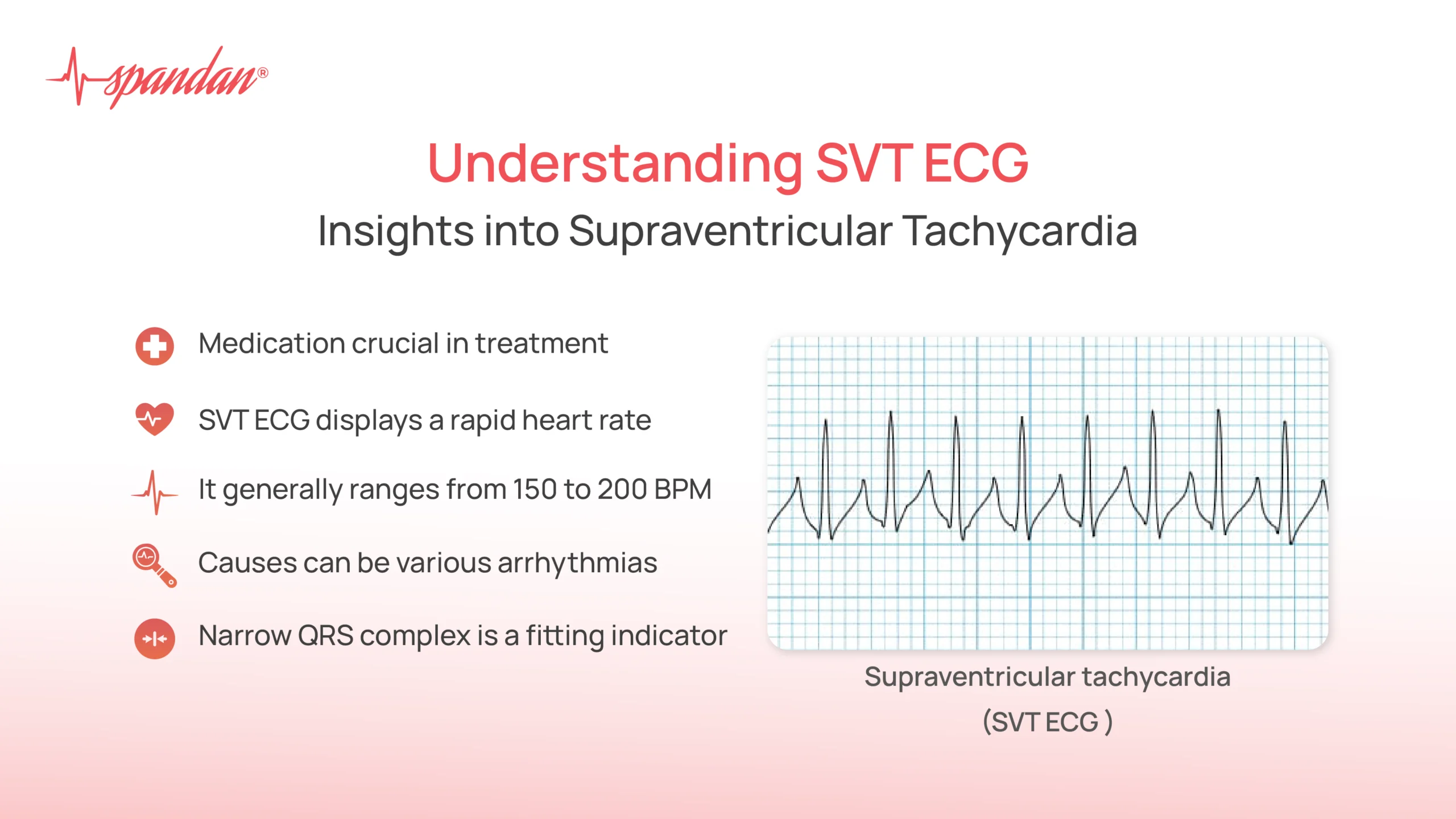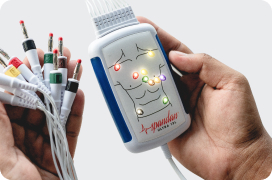
Related Article
Author:- Mr. Ritesh Sharma
In the field of cardiology, the electrocardiogram (ECG) is a cornerstone for diagnosing and monitoring various heart conditions. Among the many arrhythmias that an ECG can reveal, Supraventricular Tachycardia (SVT) is particularly noteworthy. An SVT ECG displays a rapid heart rate originating from above the ventricles, typically ranging between 150 and 250 beats per minute.
This elevated heart rate arises from abnormal electrical impulses within the atria or the atrioventricular (AV) node, causing the heart to beat rapidly. The distinct patterns observed in an SVT ECG, including regular rhythms, narrow QRS complexes, and potentially altered P waves, are crucial for accurate diagnosis and effective treatment.
Understanding SVT through its ECG presentation is essential for healthcare professionals to differentiate it from other arrhythmias, ensure timely intervention, and improve patient outcomes. This article will delve into the nuances of SVT ECG, exploring its causes, diagnostic significance, and treatment options to provide a comprehensive overview of managing this common cardiac arrhythmia.
What is SVT ECG?
An SVT ECG is characterized by a rapid heart rate originating above the ventricles, typically ranging from 150 to 250 beats per minute. This arrhythmia arises from abnormal electrical impulses in the atria or the atrioventricular (AV) node, leading to an accelerated heart rate. On an ECG, SVT is identified by its distinct features, including a regular rhythm, narrow QRS complexes, and an absence of visible P waves or altered P wave morphology.
Causes of SVT
SVT can result from various underlying conditions or triggers, including:
- Reentry Circuits: The most common cause of SVT, reentry circuits occur when electrical impulses circulate in a loop within the heart’s conduction system, leading to rapid heartbeats.
- Atrial Fibrillation or Flutter: These arrhythmias can occasionally transition into SVT, particularly in patients with underlying heart disease.
- AV Nodal Reentrant Tachycardia (AVRT): This type of SVT involves a reentrant circuit around the AV node, leading to rapid heart rates.
- AV Reciprocating Tachycardia (AVRT): Occurs due to an accessory pathway between the atria and ventricles, bypassing the AV node and creating a circuit that results in rapid heart rates.
- Pediatric SVT: In children, SVT may arise due to congenital heart defects or other structural abnormalities.
Diagnostic Significance of SVT ECG
The SVT ECG is crucial for diagnosing and differentiating SVT from other arrhythmias, such as ventricular tachycardia (VT) or atrial flutter. The distinct characteristics of an SVT ECG help clinicians identify the presence of SVT and determine the appropriate course of treatment. Key features of an SVT ECG include:
- Regular Rhythm: SVT is typically characterized by a regular rhythm with a consistent interval between beats.
- Narrow QRS Complexes: The QRS complexes are usually narrow (less than 120 milliseconds) in SVT, distinguishing it from VT, which often presents with wide QRS complexes.
- Absence or Alteration of P Waves: P waves may be absent, merged with the preceding T wave, or appear in an atypical location, making it challenging to identify the atrial activity.
By analyzing these features, healthcare professionals can differentiate SVT from other arrhythmias and determine the most appropriate treatment strategy.
Management and Treatment
Managing SVT involves both acute and long-term strategies, aiming to restore normal heart rhythm and prevent future episodes. Treatment options include:
- Vagal Maneuvers: Simple techniques such as coughing, holding one’s breath, or applying ice to the face can sometimes terminate an SVT episode by stimulating the vagus nerve, which slows down the heart rate.
- Medication: Antiarrhythmic drugs, such as adenosine, beta-blockers, or calcium channel blockers, can be used to control or terminate SVT episodes.
- Electrical Cardioversion: In cases where medication is ineffective, synchronized electrical shocks can be administered to restore normal heart rhythm.
- Catheter Ablation: For recurrent or symptomatic SVT, catheter ablation is a curative procedure where a catheter is used to destroy the abnormal electrical pathways causing the arrhythmia.
- Lifestyle Modifications: Avoiding triggers such as caffeine, alcohol, and stress can help prevent SVT episodes. Patients may also benefit from regular exercise and a heart-healthy diet.
Prognosis and Outcomes
The prognosis for patients with SVT is generally favorable, especially with appropriate treatment and management. Most individuals with SVT respond well to medications or procedural interventions, leading to a significant reduction in symptoms and improvement in quality of life.
However, some patients may experience persistent or recurrent episodes despite treatment. In such cases, ongoing monitoring and adjustments to the treatment plan are essential. Long-term management often involves regular follow-ups with a cardiologist to assess the effectiveness of treatment and make necessary adjustments.
Technological Advances in SVT Management
Advancements in technology have significantly improved the diagnosis and management of SVT. Modern ECG devices, including portable and wearable options, allow for continuous monitoring of heart rhythms, providing real-time data that can be crucial for identifying and managing SVT episodes.
Devices like the Spandan ECG facilitate remote monitoring and instant sharing of ECG results with healthcare providers, enabling prompt intervention and personalized care. Telemedicine and mobile health applications also play a vital role in managing SVT, allowing patients to track their symptoms and receive timely medical advice.
SVT ECG is a critical diagnostic tool for identifying and managing Supraventricular Tachycardia. By understanding the characteristics of an SVT ECG and its implications for patient care, healthcare professionals can provide effective treatment and improve patient outcomes.
Technological advancements continue to enhance the accuracy and efficiency of SVT diagnosis and management, offering new opportunities for better patient care. As we advance in our understanding and management of SVT, the integration of innovative ECG devices and telemedicine solutions will further elevate the standard of cardiac care, ensuring that patients receive timely and effective treatment.
In conclusion, an SVT ECG is more than just a diagnostic tool; it is a vital component in the comprehensive management of Supraventricular Tachycardia. By recognizing and interpreting the patterns on an SVT ECG, healthcare professionals can make informed decisions, providing patients with the best possible care and improving their overall quality of life.




